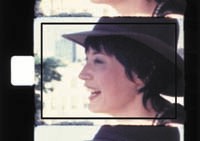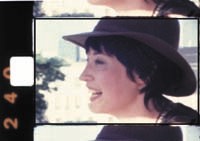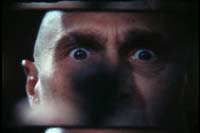Super-Duper 8 by Rick Palidwor
Article written for the Liaison of Independent Filmmakers of Toronto (LIFT) Newsletter, Sept/Oct 2002
When you insist on shooting film instead of tape but you don't have any money, super 8 is the natural choice. If you want to make it wide-screen, super-duper 8 is the way to go.
Mitch Perkins and I recently completed a feature-length drama, Sleep Always, which to our knowledge is the first feature to originate in the super-duper 8 format. (We'd previously made several music videos with this format).
WHAT'S IN A SUPER (DUPER) NAME? (a selective history of film formats)1
In 1932 8mm motion picture cameras were introduced. These cameras use special 16mm film with twice the number of sprocket holes and expose only one-half of the film at a time. Once processed, the film is slit into two 8mm strips. This format is often referred to as Double 8mm.
In 1965 Kodak introduced the super 8 format: 8mm film packaged as a single strip with smaller (and repositioned) sprocket holes, allowing it to record an image 50% larger than regular 8mm.2 This was the third time the word 'super' was used to describe a film format.3 (See Figure 1 for a comparison of typical 8mm formats.)
'Super' was used again in 1970, this time to describe a wider than normal 16mm frame. Super 16 achieved a 20% wider frame by growing in the opposite direction - toward the edge normally occupied by a second set of perfs or, in some cases, by the sound stripe. (See Figure 1 for a comparison of 16mm formats.)
In the mid-1980's, Greg Miller (one of the original owner/operators of Exclusive Film and Video, the Toronto super 8 lab) and Mitch Perkins (the film processor at the time) made an astute observation. Super 8 film - despite the "super" moniker - still had room to grow. One entire edge of the super 8 film strip was reserved for the sound stripe but could easily be turned into additional image area, as was the case with super 16. All they had to do was widen the gates on their super 8 cameras.
The technique was (and is) simple: remove the gate from the camera (provided it's held in with screws, not rivets), file down the left-hand edge, re-install. Mitch claims that they had never heard of Super 16 at the time, which is not hard to believe. Although it had been introduced to the market much earlier, Super 16 was not recognized by the International Standards Organization until 1981 and was slow to catch on in North America.
I'll never forget Mitch telling me, back in the mid-late 1980's, that he'd "shaved his gate". I scrunched my brow and shrugged. I was not involved in film at that time and had no idea what he was talking about. Little did I know that the revolution had begun.
Over the years Mitch continued to experiment with his camera gates, carving them wider and wider by small increments, expecting the running film to buckle at some point during transport. To his surprise it didn't, probably because it is so small, allowing the film to be exposed from the perfs all the way to the opposite edge, recording an image 13% wider than normal super 8. Thus, super-duper 8 was born.4 (See Figures 1 and 2)
HAZARDS OF SHOOTING SUPER-DUPER 8
There are several "flaws" with the super-duper 8 system, but they are either insignificant or easily overcome.
Technically. the system is slightly off-centre, but because it's such a small gauge it does not appear "off" to the eye and no realignment is necessary.5
Second, the camera was not designed to "see" the wider frame. (The extra 13% is on the right-hand side when looking in the viewfinder.) Therefore, you have to compose the shots with this unseen area in mind.
Also, some camera lenses are subject to vignetting on the right-hand side. This may restrict lens settings, whereby you have to avoid focusing too close or going too far to the end of the zoom ring.
APPLICATIONS OF SUPER-DUPER 8
The benefits of super-duper 8, which are precisely the same as with super 16, are only realized in projection, which can take many forms.6
Film Blow-up to 35mm
Regular super 8 has an aspect ratio (frame width divided by frame height) of 1.33:1 (as does regular 16mm). If a 1.33 frame is blown-up for 35mm release, which typically has an aspect ratio of 1.85:1, a significant portion of the frame is lost due to cropping. A super-duper 8 frame, on the other hand, has an aspect ratio of about 1.66:1 (as does super 16) and is cropped significantly less when blown-up.7
The super-duper 8 (or super 16) frame also requires less magnification to fill a 1.85 frame (compared to their regular counterparts), thus resulting in less image degradation during blow-up.
Transfer to Widescreen TV
The emerging standard for widescreen television is 16:9, which can also be expressed as 1.78:1. As with film blow-ups, super-duper 8 (and super 16) require less cropping to fill a widescreen TV frame.
Letterbox Transfer to Regular TV
A regular TV screen has an aspect ration of 4:3 (or 1.33:1). A widescreen image must be letterboxed when transferred to a 4:3 screen, otherwise the left- and/or right-hand edges would be cropped.8 In a letterbox transfer the image must be shrunk (or, more accurately, enlarged less, as with the blow-up scenario) during the transfer. As a result, grain is tighter and the image noticeably sharper.
Sleep Always was transferred to a 4:3 screen, letterboxed, as described above. Mitch made the necessary modification to his super 8 projector in the same way he modified his cameras: remove the projector gate, file down the left-hand edge, re-install.
Importantly, Mitch carved the projector gate more than strictly necessary. Since most projector gates are slightly smaller than camera gates, the outer edges of the frame, especially on the perf side, never make it to the screen in a normal telecine set-up. By carving his projector gate as much as possible Mitch ensures that no part of the image is unnecessarily lost in the transfer. In fact, the super-duper 8 frame, once transferred to tape, is about 30% wider than a normal super 8 frame.
Since Mitch had carved out his projector gate on all sides, the "raw" transferred image displayed a sliver of the adjacent frames at the top and bottom of the screen. (See Figure 3 for a sample of a "raw" super-duper 8 frame after transfer.) All the Sleep Always footage was transferred in this raw form the first time around and a 1.85:1 matte was applied digitally in the edit suite. The digital mask was too sharp for our tastes - it looked like a video effect - and although the rendering time wasn't ridiculous, it was a nuisance every time you wanted to make a trim.
Months later we re-transferred the footage and this time Mitch devised a physical 1.85 matte which was placed in the image path. The result is a softer letterbox edge, and there was no need for rendering.
FINAL WORD
We think that super-duper 8 could be the way of the future for low budget shoots that want to originate on film. The modifications are relatively simple and the resulting images are significantly better than regular super 8.
Figure 1 - A comparison of 16mm and 8mm film formats
Standard Super Regular Super Super-Duper
16mm 16mm 8mm 8mm 8mm
You will notice that the super 8 frame shown above does not extend all the way to the perforations. Most cameras in fact expose the emulsion up to the perforations but most projectors mask this tighter and you end with something like the frame shown here. The super-duper 8 frame shown above extends all the way to the perforations because in the Mitch Perkins custom super-duper 8 telecine this part of the frame actually makes it on to the screen.
Figure 2 - Frame grabs from Sleep Always
 |
 |
The picture at the right shows the full super-duper 8 frame. The picture at the left shows the same image as if it were shot with a standard super 8 camera. Notice how the picture on the right has extra emulsion exposed on the right-hand edge: this is the super-duper part of the frame. The black line inside the frames illustrates the approximate size of the final screen image after projector masking: notice how the Mitch Perkins super-duper transfer uses more of the frame by eliminating unnecessary masking. (Photo shows Laurie Maher as Nada).
Figure 3 - A frame grab from Sleep Always prior to 1.85 masking.
 Slivers of the adjacent frames are visible along the top and bottom edges. (Photo shows Ed Fielding as The Neighbour).
Slivers of the adjacent frames are visible along the top and bottom edges. (Photo shows Ed Fielding as The Neighbour).
Footnotes
1 The following discussion of film formats touches on a few historical points as they relate to super-duper 8. The history of film formats is much more complex - there have been nearly 100 different formats since Edison introduced his Kinetoscope in 1894. An excellent history by Michael Rogge, "More than 100 years of films sizes", can be found at http://www.xs4all.nl/~wichm/filmsize.html. See also http://www.film-center.com/formats.html for an informative table of film formats in history by Mark Baldock. Unless otherwise stated, the technical data sighted here was lifted from these two sources.
2 Super 8 was revolutionary for a number of reasons. Visit http://www.kodak.com/US/en/motion/super8/ for more information.
3 Super Technirama was introduced in 1958 and Super Panavision in 1959. Neither is in use today. For details go to http://www.film-center.com/formats.html .
4 Interestingly, Michael Rogge claims that "there are suggestions to enlarge the image size [of super 16] even further by introducing vertical perforations similar to those used in super 8mm." If they're stuck for a name we'll suggest "super-duper 16".
5 In a 16mm environment modifications to the camera were necessary for the conversion to super 16. Visit http://www.factsaboutfilm.com/Resources/S16Guide/s16guideframeset.html for more information.
6 Both super 16 and super-duper 8 sacrifice the sound stripe area of the film. In the applications outlined here, however, the sound stripe area would never be used anyway, so it's really no sacrifice at all.
7 A super 16 blow-up increases the useable image area by 46%, compared to standard 16 when blown-up. See http://www.factsaboutfilm.com/Resources/S16Guide/s16guideframeset.html for more details. A super-duper 8 blow-up would probably result in similar increases in usable image area compared to standard super 8.
8 The alternative to a letterbox transfer is a "pan and scan", sometimes referred to as "fucking pan and scan", whereby a cropped image fills the entire screen and (in theory) the transferred image is recomposed (panned and scanned) when important details happen off screen (in the cropped part). It's rarely done well and is a poor substitute for showing the entire wide-screen image. Call TV stations to complain when this happens. I once saw an extreme close-up of the bridge of Bill Pullman's nose on Showcase.
Copyright ©2002 Friendly Fire Films, All Rights Reserved.

